I bought the Celestron SkyMaster 20×80 Binoculars to use in my backyard for stargazing and to experiment with for astrophotography.
This is my review based on my experience over the past few years as an amateur astronomer which I hope will be useful to you.
You can watch my video review here:
Overall, I think these make a great option for someone looking for a first pair of astronomy binoculars or if you are looking for an alternative to a telescope.
They are easy to use and high quality, and built specifically with astronomy in mind.
However, it is worth understanding what they are suitable for and their limitations to make sure they are right for you. In particular in terms of the views you will get, and that they need to be used with a tripod.
Use the links below to check availability and price at a number of retailers right now or read on for my complete review.
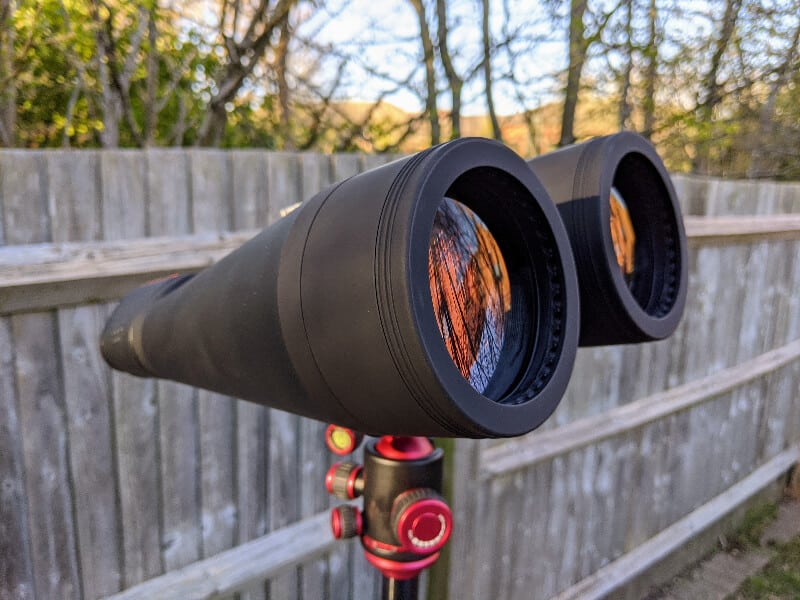
Astronomy Binoculars vs Regular Binoculars: What’s the Difference?
Before we get stuck in, it’s worth just covering the difference between regular and astronomy binoculars:
- Magnification and Aperture: Astronomy binoculars typically have a higher magnification and larger aperture (the diameter of the lens) compared to regular binoculars. A larger aperture allows more light to enter, which is crucial for viewing faint celestial objects in the night sky. Regular binoculars usually have smaller lenses and lower magnification, as they are designed for daytime use or for viewing terrestrial objects at closer distances.
- Field of View: Regular binoculars often have a wider field of view, which is useful for activities like bird watching or sporting events where you need to track moving objects. Astronomy binoculars, on the other hand, usually have a narrower field of view, which is better for focusing on specific areas of the night sky.
- Weight and Size: Due to their larger lenses astronomy binoculars tend to be heavier and larger than regular binoculars.
- Focus: Regular binoculars are designed to focus on relatively close objects, while astronomy binoculars are designed to focus on distant objects.
So, if you want binoculars for stargazing, then it is worth going specifically for a pair of astronomy binoculars, rather than just trying to use a regular pair designed for daytime use.

Astronomy Binoculars vs Telescopes
I also just want to touch on the pros and cons of binoculars versus telescopes for astronomy. I have a whole article on this that you can read here – Binoculars vs Telescopes for Astronomy.
But to summarize the advantages of astronomy binoculars:
- Easier to use – They are more intuitive to point and focus, and because they provide a view with both eyes, the viewing experience is more natural. In contrast, learning to set up, align a telescope, and navigate the night sky with it, can be a steep learning curve.
- More portable – They are easier to carry around and set up, making them great for impromptu stargazing sessions or for taking on trips. Telescopes, especially larger models, can be heavy and bulky to transport.
- Have a wider field of view – This makes it easier to find objects in the sky. This can be particularly helpful for beginners.
- More versatile – Binoculars can be used for a variety of activities, not just astronomy. They can be used for bird watching, hiking, sports, etc.
- Cheaper – Generally, a good pair of binoculars is less expensive than a good telescope. This makes them a less risky investment for someone just starting out in the hobby.
On the other hand, the advantages of telescopes are:
- Higher viewing power – Telescopes can provide much higher aperture and magnification than binoculars, allowing you to see more detail on the moon, planets, and deep-sky objects.
- Upgrade Options – Telescopes offer a wide range of accessories and upgrades, such as different eyepieces, filters, and motorized mounts.
- Astrophotography – A telescope is better for astrophotography. While you can take some basic photos with binoculars and a smartphone, a telescope will allow you to take much better images and capture different things.
In general, most people into stargazing will probably end up owning both a telescope and a pair of binoculars (but they probably won’t buy both at the same time).
Astronomy binoculars make a great first option for a beginner dabbling in stargazing and if it ends up sparking a passion they will probably end up investing in a telescope later.
You can go to our guide to the Best Astronomy Binoculars, or read on for our review of the 20×80 Skymasters.
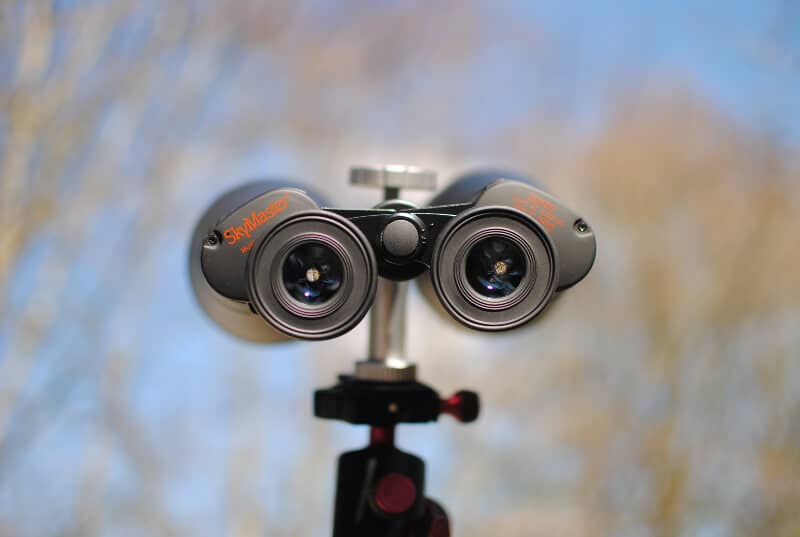
Celestron SkyMaster 20×80 Binoculars Review
Just as a quick overview, Celestron is one of the leading manufacturers of astronomy gear in the world, ranging from beginner to advanced.
They have a number of different ranges of binoculars, some of which are for terrestrial use and some for astronomy use.
On the Celestron website, I can see at the time of writing:
- 66 different binocular models, from
- 13 different ranges
The SkyMaster range is the primary range for astronomy with 13 different models.
There are also individual Cometron and Echelon models also for astronomy, with the other ranges being for terrestrial use like nature and bird-watching. See further below for how these compare to the SkyMaster 20x80s.
Unboxing the Celestron SkyMaster 20×80 Binoculars
The Celestron SkyMaster 20×80 Binoculars come in a mid-sized box that is not too heavy and contains:
- Binoculars
- Carrying case
- Objective lens cap
- Rain guard
- Neck strap
- Lens cloth
- Instruction manual
They are pretty easy to take out of the box and get going with immediately (more on usability below). They feel reassuringly heavy and well-made, with a sleek black appearance.
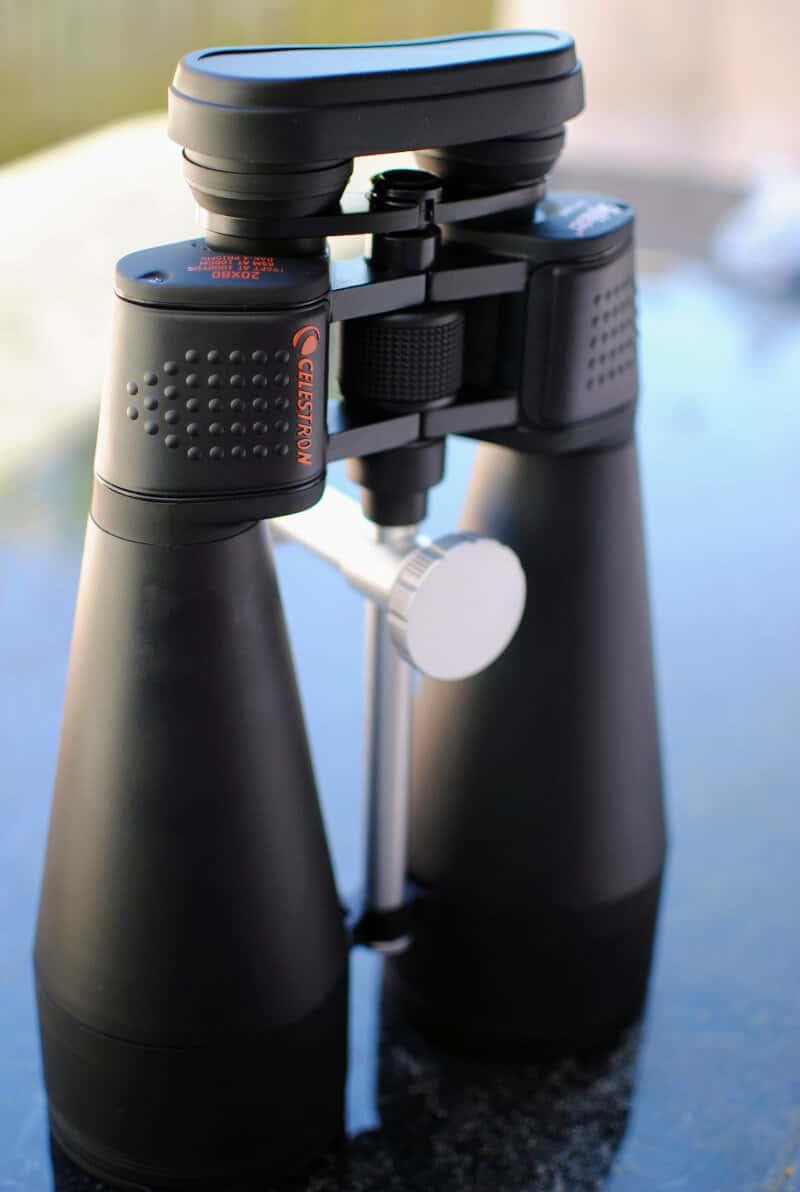
Key Features and Specifications
The two key specifications of these binoculars are in the name (as is common for binoculars):
- the “20” in the model name refers to the 20x magnification
- the “80” refers to the aperture (the size of the lens) with 80mm millimeters
The 20x magnification means that you will see objects 20 times closer. Two key things to know about this are:
- Magnification not only magnifies the view but also magnifies the natural shakiness that we all have in our hands. For this reason, these binoculars (and any other pair over 10x) will need to be used with a tripod to get the best out of them.
- High magnification without a high aperture will give you a poor viewing experience because any distortion or lack of clarity in the view from a low aperture or poor-quality build will also be magnified.
This second point leads us to the 80mm aperture. At 80mm this is fairly high. With aperture, it is simply the higher the better.
Higher aperture means better quality views in terms of brightness and clarity and is very important to consider when buying astronomy binoculars or a telescope.
For context, I usually recommend a minimum of 70mm aperture for a beginner telescope.
The only downsides to higher aperture are that the binoculars (or telescope) will be bigger, heavier, and more expensive.
The other key things to mention are:
- They have an in-built tripod mounting rail, so you don’t need any additional adapter to attach them to a regular camera tripod
- There is a central dial to adjust the focus
- The eye relief is 18mm. This is the measurement of how far you can have your eye from the eyepiece and for glasses wearers you want this to be above 14mm.
- The weight is 2.1 kg (4.7 lbs)
- They are water-resistant and durable
You will see other things mentioned like the Porro Prisms, Bak-4 glass and Multi-Coated lenses but I don’t think you need to think too much about this. Ultimately you just need to know that these are built for astronomy and so are optimized for that whilst being in a mid-range price bracket.
You can see the full list of specifications on Celestron’s website.
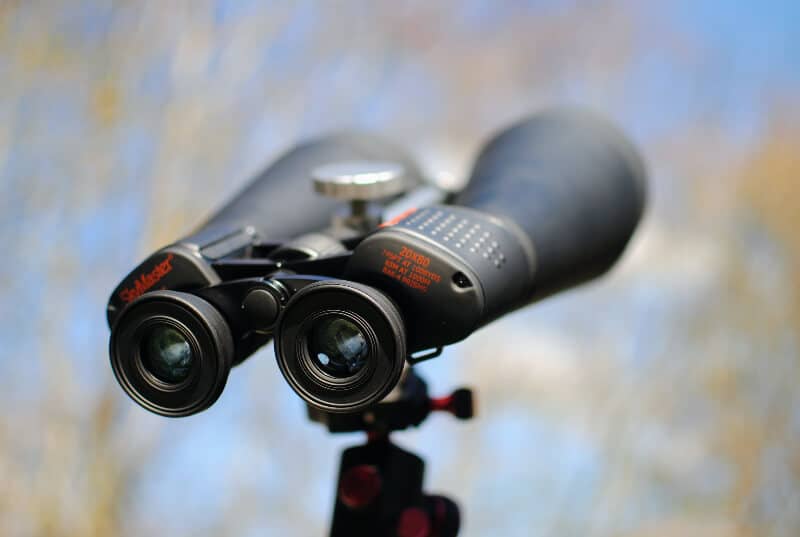
Ease of use
Once you get them out of the box they are pretty much ready to get going. This is great for beginners as telescopes can often be overwhelming and have quite a few steps to go through to get them working.
The only real adjustment you need to make is focusing with the central dial. This is just a matter of looking through and then turning this until the views are clear and sharp as you can get them. Note that each eye can be focused separately which is a useful feature.
As mentioned above, these should be used with a tripod for best results. They are a powerful piece of gear and need to be steady to give you the good views of astronomical objects you are looking for. This model has an in-built tripod adapter and so no extra component is needed (for some of the other SkyMaster models you need to buy this separately.)
Of course, you need to own a tripod or buy one. It should fit any standard camera tripod with nothing specific for astronomy binoculars needed, but if you are interested we do have a guide to the Best Tripods for Astronomy Binoculars.
There should be no need for collimation. This is the process of adjusting the mirrors inside and is required with some telescopes. However, there are stories of people having to collimate Celestron binoculars and there are instructional videos on YouTube of people doing it themselves.
To emphasize though, I didn’t have to do this and you shouldn’t have to. If you have a problem like this, Celestron’s customer support should be able to help you.
The only real maintenance needed is to keep them stored in a dry place. They pack up conveniently in the carry case and are not an awkward shape at all, so they are easy to store and also travel with.
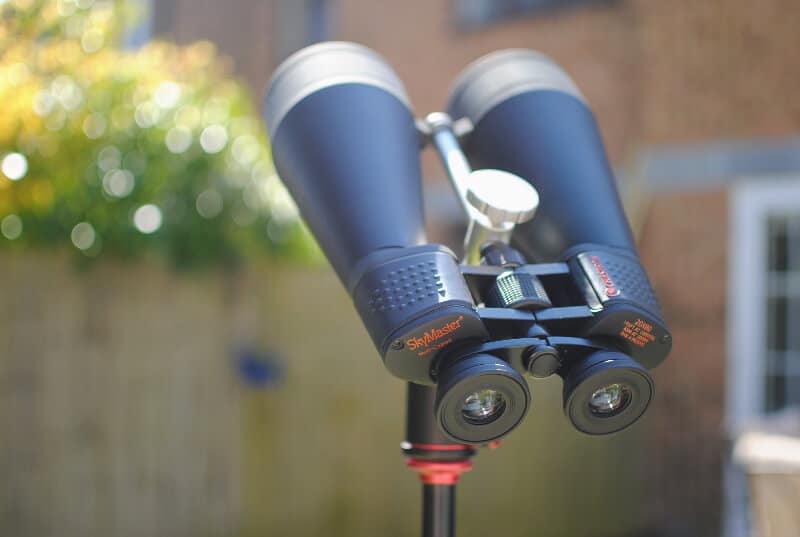
Viewing Experience
Like with any stargazing, what you will be able to see will depend on where you are and specifically the level of light pollution where you are viewing.
What you should be able to see through these though should include:
- The moon in great detail
- Some of the planets of the solar system – including Jupiter and the rings of Saturn (these will be faint though)
- Some large galaxies and clusters – for example, M31, M33, and the Pleiades star cluster.
(Obviously, you should never look at the sun through these binoculars or you risk seriously damaging your eyes.)
Finding and viewing these objects (beyond the moon) will take time, practice, and persistence but that should be part of the fun and what makes it rewarding when you do see things.
Overall though, the image quality and light-gathering ability of these binoculars is great. They provide bright images of distant objects and deep sky objects, with stars appearing sharp.
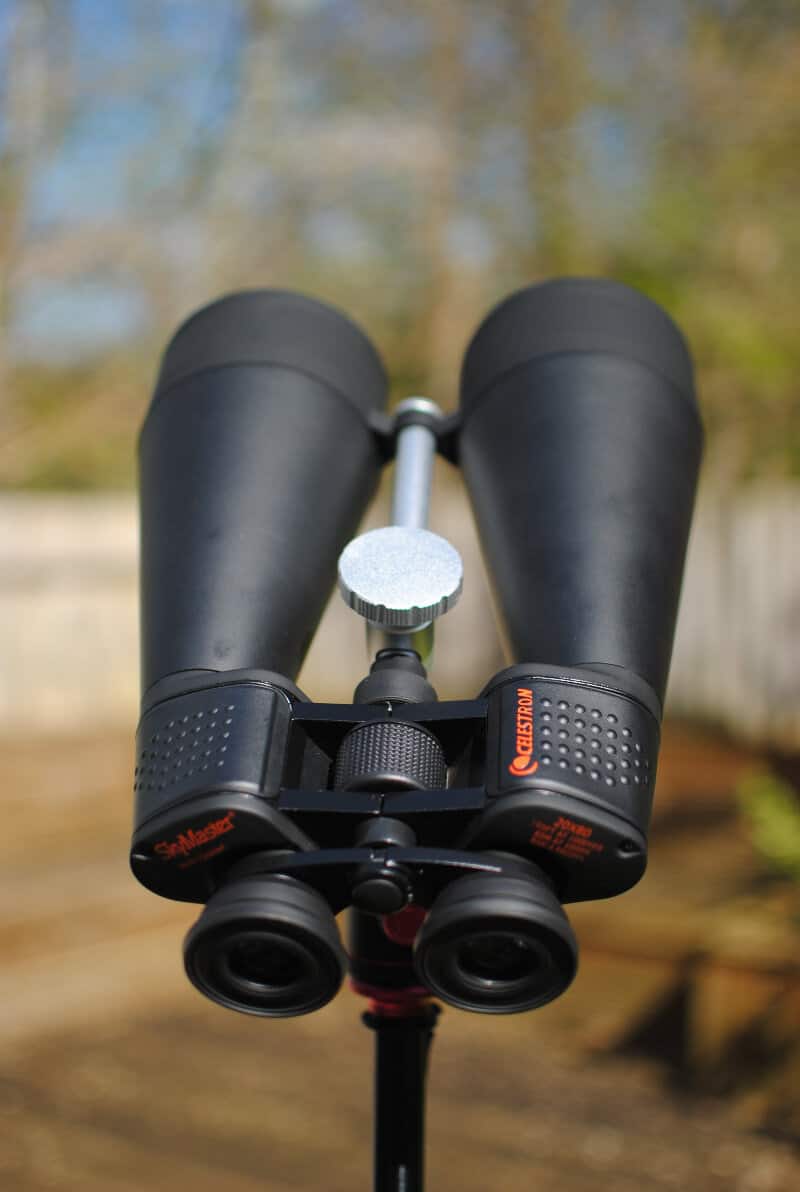
Astrophotography
I wanted to have a go at using these binoculars for astrophotography. They are not designed for this purpose and will generally not be as suited for this purpose as a telescope, but it can be done.
The way to do this is to attach your smartphone to the lens using an adapter that you need to buy separately. There are two options from Celestron for this:
- The Basic Celestron Smartphone Adapter (that I’ve used in the pictures below), and
- The Celestron NexYZ 3–Axis Universal Smartphone Adapter – This is a better quality build and holds the phone more securely, but is a bit more expensive.
Both of these will work with any smartphone and any binoculars or telescope. You can see below how it works.
Firstly, you attach the adapter to the binocular lens:
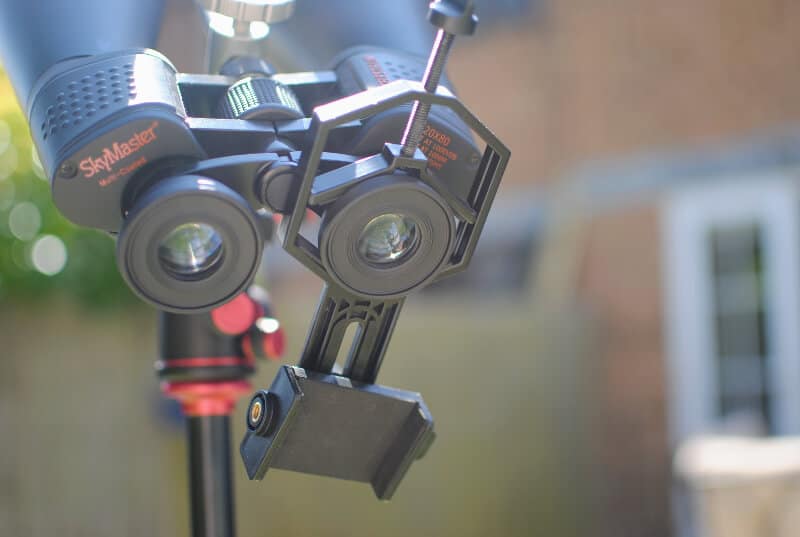
Then you insert your phone into the adapter and align the phone’s camera lens with the binocular lens:
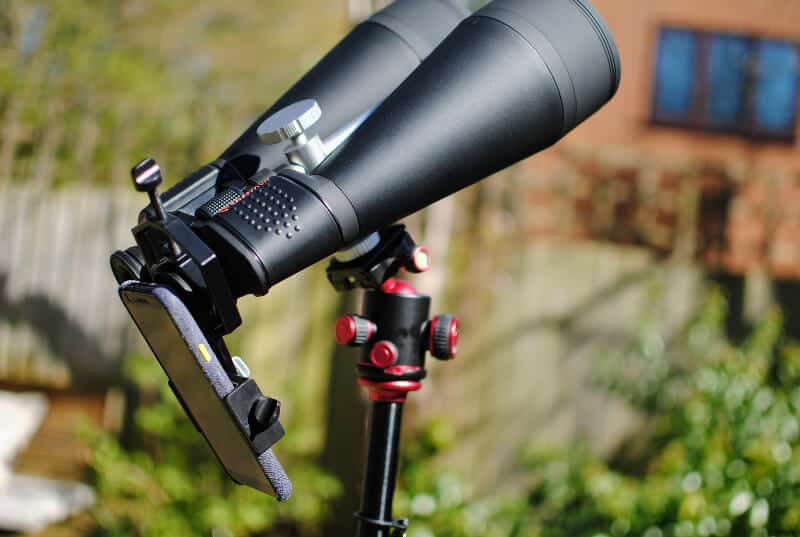
You then use the camera app on your phone to take pictures. You will need to use a countdown timer to take the picture to minimize any vibrations from you pressing the button on your phone when taking the picture.
You can also buy a remote shutter device for your phone to help with this.
Here’s an image of the moon I managed to take on my first try:
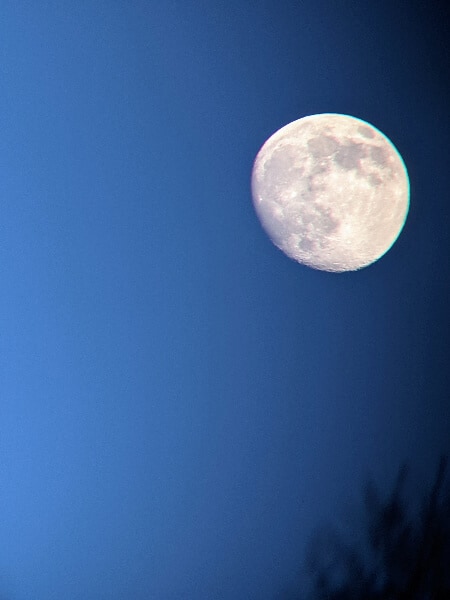
You can see that it’s not perfect and the image is not as sharp as you’d want, but this literally took a few minutes to put together.
Recommended accessories
There are two key accessories that you will want to make the most of these binoculars:
- A tripod
- A smartphone adapter
For the tripod, any regular photography model will do, but if you want to buy something new then the Celestron Ultima Pan Tilt Head Tripod is a great option.
See our guide to the Best Tripods for Astronomy Binoculars for alternatives.
For a smartphone adapter, see the two options recommended above.
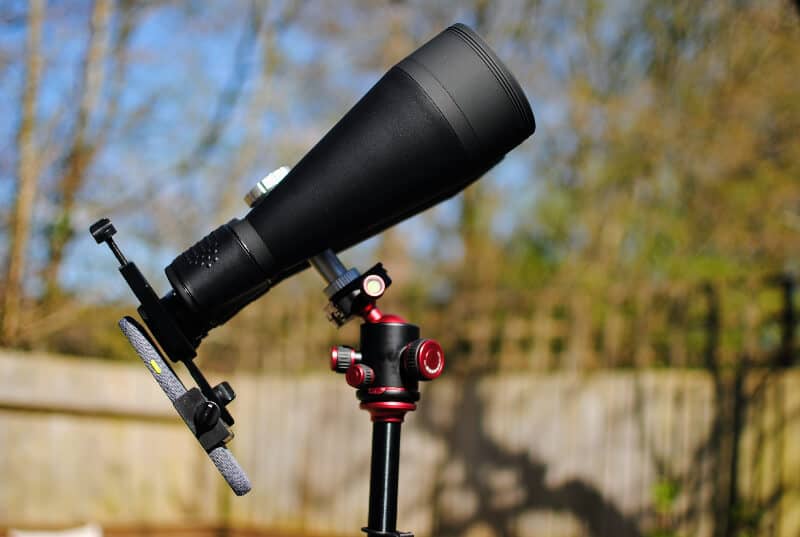
What I Like About These Binoculars
- They provide great views with the 80mm aperture
- They are very easy to use and great for beginners or just someone who wants a quicker option than setting up a telescope
- They are of sturdy build and good quality
- They are relatively cheap to buy
- They are easy to store and transport
From reviewing what others have said about these binoculars, they are highly rated for their ease of use, image quality, and sturdy build.
What I Don’t Like About These Binoculars
- You have to use a tripod which kind of takes away from the grab-and-go appeal of binoculars in comparison to telescopes
- Whilst the views you can get with these are good, don’t have too high expectations about getting crystal clear views of things like the rings of Saturn for instance. You need big aperture for things like this and a more powerful model or a telescope would be better.
- They are not really great for astrophotography (nor should they be), but it can be fun to play around with this using a smartphone and adapter
Other complaints raised by other users of these binoculars include:
- The tripod attachment has a small screw size which needs to be tightened very tight, causing some to fear damaging the aluminum threads.
- There’s a bit of chromatic aberration visible when looking at bright objects like the moon.
- The case that comes with them is fairly lightweight and will not offer much protection when traveling.
- Some users find the focus knobs to be a bit stiff.
- Since each side is individually focused, every time a different person uses them they have to refocus both sides and so can be a bit of a pain if you are using them with others. For example, sat out together at night when camping.
Overall though, I recommend these binoculars as a great bit of gear for a stargazer of any level.
They are powerful enough for an experienced astronomer to enjoy, as well as appreciate the speed and ease of setting them up.
For beginners, they are a perfect introduction to astronomy gear, that iare easy to use but also have the potential to give you a great experience.
Celestron SkyMaster 20×80 Alternatives
Since you’re exploring buying the Celestron Skymaster 20×80 Binoculars, you are probably interested in understanding the alternatives.
There are four main options for this:
- The Pro version of these binoculars
- Different models within the Celestron SkyMaster range
- The Celestron Echelon 20×70 Binoculars
- 20×80 binoculars from other astronomy manufacturers
Let’s look at each in turn.
Celestron Skymaster 20×80 vs Pro
If you weren’t already aware, there are two versions of the Celestron Skymaster 20x80s:
- The basic Celestron Skymaster 20×80 Binoculars that I am reviewing here
- The Celestron Skymaster Pro 20×80 Binoculars – these are a more premium upgrade and cost roughly twice as much (although check the prices as Celestron binoculars nearly always get included in sales)
What you get for spending the extra money on the Pro model is:
- Improved weatherproofing – They are waterproof and nitrogen-purged for use in all conditions and to prevent condensation on the lenses when transitioning from cool outside temps to indoor.
- Improved lens coatings – they have “Celestron’s proprietary XLT coating” which make views a little crisper.
- A lighter-weight design due to the use of polycarbonate and aluminum housing.
- A detachable RSR rail for attaching a red dot finderscope
Overall, they are a slightly high-quality build. If you have the budget then you probably won’t regret going for the Pro version, but most people will be fine and happy with the regular version.
Check prices and availability of the Celestron Skymaster Pro 20×80 Binoculars.
Celestron SkyMaster 20×80 vs 15×70 or 25×100
There are a number of other models in the SkyMaster range, including:
They vary in terms of the magnification/aperture, as well as some with zoom magnification, and the Pro versions.
For most people considering the 20x80s, you will likely be considering the cheaper 15x70s or the more expensive 25x100s.
Overall, none are really “better” once you take into account the price. Essentially, they get more expensive as the aperture increases and higher aperture means better views.
Remember, higher magnification means you get closer in to what you are viewing but gives you a narrower field of view, so is not necessarily a case of ‘higher is better’.
You pretty much get what you pay for in this range, so just look at your budget and what you want to spend.
Whilst I have the SkyMaster 20x80s and love them. I also have the Celestron Cometron 7×50 binoculars that I use for scanning the night skies when events like meteor shows are scheduled.
Celestron SkyMaster 20×80 vs Celestron Echelon 20×70
Another model you may come accross are the Celestron Echelon 20×70 Binoculars.
These are a more premium option that cost quite a bit more. The advantage is that they boast higher quality lenses and coatings that seem to be highly rated by users.
Again, if you have the money you will probably be happy spending the extra on these but most will be happy with the more budget-friendly SkyMaster options.
Celestron SkyMaster 20×80 vs Zhumell 20x80s
The final alternatives to consider are 20×80 astronomy binoculars from other recognized brands, including the /Zhumell 20×80 Giant Astronomical Binoculars
There is very little difference between these and the Celestron SkyMaster 20×80 Binoculars and so worth considering if you can find these for substantially cheaper.
However, with Celestron you do get a two-year warranty as well as reliable customer support and good resources like their YouTube Channel, where they have lots of good “how-to” videos.
My recommendation is to go with Celestron unless the price at the time of buying is substantially more then these alternatives.
My Verdict on the Celestron SkyMaster 20×80 Binoculars
Overall, I thoroughly recommend getting a pair of these binoculars, especially if you are a beginner.
They are easy to use and this bypasses the problem that can sometimes happen when they get a first telescope and that they find it too hard and get discouraged and give up.
They also have the potential for giving you great views. Just remember to fit them to a tripod and use an app like SkySafari or Stellarium to see what’s in the night sky above you that night.
Celestron SkyMaster 20×80 Binoculars

Pros
- 80mm aperture and 20x magnification for a great viewing experience
- Easy to use for astronomy beginners
- Great value for the price
Cons
- Need to be used with a tripod for the best experience
- 80mm aperture is mid-range, so don't have viewing expectations too high
Celestron SkyMaster 20×80 Binoculars Review (Astronomy & Astrophotography)
Are the Celestron SkyMaster 20×80 Binculars right for you?Watch this video to understand the pros and cons and what other models you might want to consider._…
Celestron SkyMaster 20×80 Binoculars

Pros
- 80mm aperture and 20x magnification for a great viewing experience
- Easy to use for astronomy beginners
- Great value for the price
Cons
- Need to be used with a tripod for the best experience
- 80mm aperture is mid-range, so don't have viewing expectations too high
Celestron SkyMaster 20×80 Binoculars Review (Astronomy & Astrophotography)
Are the Celestron SkyMaster 20×80 Binculars right for you?Watch this video to understand the pros and cons and what other models you might want to consider._…
Celestron SkyMaster 20×80 Binoculars

Pros
- 80mm aperture and 20x magnification for a great viewing experience
- Easy to use for astronomy beginners
- Great value for the price
Cons
- Need to be used with a tripod for the best experience
- 80mm aperture is mid-range, so don't have viewing expectations too high








I just received the celestron skymaster 20×80 binoculars and I noticed that the right eye lens is adjustable but the left eye lens was not. Is that normal?
Darnell, you are meant to close your eye on the right first, then use the main focuser to get the left side dialed in. After that, you close the left eye and adjust the individual focuser on the right lens to get as sharp as you did the left side when you used to main focuser. After you’re done with the right side, you’re all set.